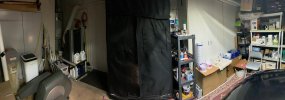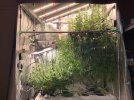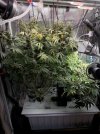Perfect!VDP is 1.04
You are using an out of date browser. It may not display this or other websites correctly.
You should upgrade or use an alternative browser.
You should upgrade or use an alternative browser.
RDWC PPM QUESTION NEED A QUICK RESPONSE PLEASE!
- Thread starter legitroller
- Start date
legitroller
Well-Known Member
@Delps8 late reply so I mainlined the plants and every time they would get to the third node I topped and cut a few leaves off to help with growth and energy transfer. I did read about VDP, and thanks for the link. Nice write-up, btw, my VDP stays around 1.02 1.04. I did notice only on one branch some yellow tips, but nothing to be concerned about too much, plus they grew into the light, so I just raised it lol. I did learn the trick of adding just water to fluctuate the PPMs down EC. So naw I'm going to use that open sesame I'm just going to use Koolbloom. Man, thanks for all the information you and @Thurston provided, I'm following you guys. Once I get time to edit all my videos and upload to YouTube, y'all can check out the full process, cause I've recorded this whole grow lol, but I'm never going back to soil lol. I'm thinking of switching to the Lotus powder line, heard great reviews .
I'd like to hear your thoughts on mainlining, if you get a chance.@Delps8 late reply so I mainlined the plants and every time they would get to the third node I topped and cut a few leaves off to help with growth and energy transfer. I did read about VDP, and thanks for the link. Nice write-up, btw, my VDP stays around 1.02 1.04. I did notice only on one branch some yellow tips, but nothing to be concerned about too much, plus they grew into the light, so I just raised it lol. I did learn the trick of adding just water to fluctuate the PPMs down EC. So naw I'm going to use that open sesame I'm just going to use Koolbloom. Man, thanks for all the information you and @Thurston provided, I'm following you guys. Once I get time to edit all my videos and upload to YouTube, y'all can check out the full process, cause I've recorded this whole grow lol, but I'm never going back to soil lol. I'm thinking of switching to the Lotus powder line, heard great reviews .
Nice that the VPD stays right at 1.0. I'm in Southern California so I can't do a summer grow. July/August will be a challenge for you. I looked up "hot and humid" in the dictionary and it showed a picture of Maryland!
I used Fox and Botanicare but switch to Jacks 3-2-1. Bottles are convenient but it only takes a few minutes to mix a batch. The labor is pumping out the res. My res holds 28 gallons so it's really stable (pH and EC) but I have a to run a sump pump to move around that much water. I only do three res changes during a grow so it's not all that bad. You're dealing with a lot of water, as well. Between the totes and the res, how many gallons in your system?
"I'm never going back to soil lol"— I hear ya. Hydro requires more think time up front but there's no mystery about what your plants are getting.
I checked out your "buckets" and "reservoir" and the buckets look like storage bins. Is that a DIY system?
legitroller
Well-Known Member
So my system is totally DIY unions for easy disconnect, yes, storage totes, and a trash can for a res lol. Hygger DC Water Pump 800GPH 6-inch net pots 600w Ballast 8-inch exhaust fan for the light. Use a boogie Plus filter for my water. I use a 10,000 BTU air conditioner that's set to 72F that automatically cuts on. I use an AC Infinity humidifier that barely comes on, cause the humidity stays at a consistent 68% highest it has gotten being 72%. The tent stays at 75 to 80°F consistently. My reservoir is 20 gallons. I use a trash can to mix feed and dump old water. I use a drill and a mixing blade to mix lmao. My feed line is GH floral trio micro, grow, bloom, and Photosynthesis Plus, oh, and 20 ML of Mad Farmer oxygenator. I like mainlining, I get an even canopy, even energy uptake, yes, longer veg time, but more tops and bigger yields, quality over quantity. You should try itI'd like to hear your thoughts on mainlining, if you get a chance.
Nice that the VPD stays right at 1.0. I'm in Southern California so I can't do a summer grow. July/August will be a challenge for you. I looked up "hot and humid" in the dictionary and it showed a picture of Maryland!
I used Fox and Botanicare but switch to Jacks 3-2-1. Bottles are convenient but it only takes a few minutes to mix a batch. The labor is pumping out the res. My res holds 28 gallons so it's really stable (pH and EC) but I have a to run a sump pump to move around that much water. I only do three res changes during a grow so it's not all that bad. You're dealing with a lot of water, as well. Between the totes and the res, how many gallons in your system?
"I'm never going back to soil lol"— I hear ya. Hydro requires more think time up front but there's no mystery about what your plants are getting.
I checked out your "buckets" and "reservoir" and the buckets look like storage bins. Is that a DIY system?
Attachments
legitroller
Well-Known Member
@Delps8 So my system is DIY, unions for easy disconnect, storage totes, and a trash can for a res lol. Hygger DC Water Pump 800GPH 6-inch net pots 600w Ballast 8-inch exhaust fan for the light. Use a boogie Plus filter for my water. I use a 10,000 BTU air conditioner that is set to 72F and automatically cuts on. I use an AC Infinity humidifier that barely comes on, cause the humidity stays at a consistent 68% highest it has gotten being 72%. The tent stays at 75 to 80°F consistently. My reservoir is 20 gallons. I use a trash can to mix feed and dump old water. I use a drill and a mixing blade to mix lmao. My feed line is GH floral trio micro, grow, bloom, and Photosynthesis Plus, oh, and 20 ML of Mad Farmer oxygenator. I like mainlining, I get an even canopy, even energy uptake, yes, longer veg time, but more tops and bigger yields, quality over quantity. You should try itI'd like to hear your thoughts on mainlining, if you get a chance.
Nice that the VPD stays right at 1.0. I'm in Southern California so I can't do a summer grow. July/August will be a challenge for you. I looked up "hot and humid" in the dictionary and it showed a picture of Maryland!
I used Fox and Botanicare but switch to Jacks 3-2-1. Bottles are convenient but it only takes a few minutes to mix a batch. The labor is pumping out the res. My res holds 28 gallons so it's really stable (pH and EC) but I have a to run a sump pump to move around that much water. I only do three res changes during a grow so it's not all that bad. You're dealing with a lot of water, as well. Between the totes and the res, how many gallons in your system?
"I'm never going back to soil lol"— I hear ya. Hydro requires more think time up front but there's no mystery about what your plants are getting.
I checked out your "buckets" and "reservoir" and the buckets look like storage bins. Is that a DIY system?
Attachments
Thanks for the details. I'm chuckling as I read it because we're dealing with similar problems/needs and going about them in slightly different ways.@Delps8 So my system is DIY, unions for easy disconnect, storage totes, and a trash can for a res lol. Hygger DC Water Pump 800GPH 6-inch net pots 600w Ballast 8-inch exhaust fan for the light. Use a boogie Plus filter for my water. I use a 10,000 BTU air conditioner that is set to 72F and automatically cuts on. I use an AC Infinity humidifier that barely comes on, cause the humidity stays at a consistent 68% highest it has gotten being 72%. The tent stays at 75 to 80°F consistently. My reservoir is 20 gallons. I use a trash can to mix feed and dump old water. I use a drill and a mixing blade to mix lmao. My feed line is GH floral trio micro, grow, bloom, and Photosynthesis Plus, oh, and 20 ML of Mad Farmer oxygenator. I like mainlining, I get an even canopy, even energy uptake, yes, longer veg time, but more tops and bigger yields, quality over quantity. You should try it
The quick disconnect makes it easy to move things around. Any issues with leaks?
You have a true RDWC meaning a separate res. My set up is one big res but I run the water to a chiller so it does "recirculate" but only sorta/kinda. No mention of a chiller so your res temp is…low 70s's? You're running bennies or "living life in the fast lane"?
It's great that you have such stable temps. I'd love to have temps + RH that are that stable. MY grow is in a 20' x 20' garage. I'm about 10 miles from the ocean so the temps aren't too bad. If I was another 5 miles inland, it's another 5°. There are three climate types inside of a radius of about 10 miles. The house is from 2000± so construction quality isn't the best and the concrete floor in the back left corner of the garage is 72° all year round. It still gets into the 60's in the winter and high 80's in the summer so I start grows in Sept/Oct and then January. One "summer" grow was enough.

"trash can" + "drip and paddle mixer" - great idea. I hadn't thought that. I mix in a 32 gallon trash can so I mix the nutes with a paddle. Just laughed thinking about that—I do two grows a year and only 3 res changes so I use the damn thing a total of 6 times a year.
"mainlining"—I appreciate the suggestion. I (should always) grow one plant at a time.
A "Twinz" grow. This doesn't work. I ended up fox tailing the big plant and ended up having to get the Vipar XS 1500 anyway.


Most recent grow. I had to cut off the left half of the smaller plant to get everything to fit. That's why I say "I (should always) grow only one plant."

The reason I'm thinking about mainlining is that this is the only grow I've done with a really flat canopy. That's a photoperiod plant and I think I vegged for 60± days to get her to cover the grow area like that. The other plants tend to grow taller, per above.
I topped and used fishing weights to get the lateral growth but I think it would be a lot easier if I were to mainline.
Mainlining sounds simple but is it really that simple? Will the plant just fill out sideways? Also, I'd like to do an auto grow. I've had no issues with autos in terms of size because of the hydro/high temps/lotsa light combination. When you mainline, do you have to veg for >40 days to get them to fill out (40 days being about the time autos go into flower)?

legitroller
Well-Known Member
@Delps8 So the unions are for quick disconnect and clean out. I use 2-inch Uniseal, which works perfectly and has no leaks. Plus, for extra precaution, I use the aquarium silicone right on the joint between the seal. I use a chiller, it's a Vevor 92gal and works perfectly and quietly the water stays at 72°F solid not for the plant in the back, the water stays a 76 78. The roots have no problem, plus I use the Mad Farmer Oxygenator. Now I don't pay that price, I get it from my local hydro store for $15 . I only pay 40 for the GH trio, all gallons , but yep. When it comes to mainlining, the trick is to start it early and make sure it's a U shape. So now sativa's grow long and lengthy headache but easy to bend and not your ideal for mainlining because of such, so you'll have an intertwined roller coaster sativa plant like mine LMAO . The object of mainlining is to get an even energy distribution, so you have two main lines. Now the how to: train early so you top at the 4th or third node and cut anything below it, but leave some fan leaves. When the two main colas mature enough, repeat the process on Andrew strip until you get as many tops as you want and bend evenly, then let them grow, maintain the even canopy, and smoke some great weed . Get yourself a paddle mixer you'll love it The trashcan res has an air stone in it as well
Good that you're not chasing leaks. Some growers DIY and have to redo some of the plumbing. Nice to have the separate containers and the big grow space. I'm pretty much limited to a 2' x 4'.@Delps8 So the unions are for quick disconnect and clean out. I use 2-inch Uniseal, which works perfectly and has no leaks. Plus, for extra precaution, I use the aquarium silicone right on the joint between the seal. I use a chiller, it's a Vevor 92gal and works perfectly and quietly the water stays at 72°F solid not for the plant in the back, the water stays a 76 78. The roots have no problem, plus I use the Mad Farmer Oxygenator. Now I don't pay that price, I get it from my local hydro store for $15 . I only pay 40 for the GH trio, all gallons , but yep.
H2O2 for the roots. Good idea. I had one small instance of root rot—nasty.
$40 for GH is great. When I was looking for something besides Botanicare, it was either Jacks or GH. I think I liked the sound of "Jacks 3-2-1 for RO" so I went with that but I don't see that it makes much of a difference.
Mainlining sounds pretty straightforward and I've got to do something to fill out my canopy more. How long do you veg your plants?When it comes to mainlining, the trick is to start it early and make sure it's a U shape. So now sativa's grow long and lengthy headache but easy to bend and not your ideal for mainlining because of such, so you'll have an intertwined roller coaster sativa plant like mine LMAO . The object of mainlining is to get an even energy distribution, so you have two main lines. Now the how to: train early so you top at the 4th or third node and cut anything below it, but leave some fan leaves. When the two main colas mature enough, repeat the process on Andrew strip until you get as many tops as you want and bend evenly, then let them grow, maintain the even canopy, and smoke some great weed . Get yourself a paddle mixer you'll love it The trashcan res has an air stone in it as well
legitroller
Well-Known Member
@Delps8 Well mind you these plants are my first RDWC grow so a long time lmfao so I killed a peanut butter breath due to a stupid mistake that could had killed me too then I had trouble getting seeds to pop then once they did pop had trouble with them rooting because I didn't fill the water half way into the net pots and or top feed stupid mistakes so needless to say from the picture below too damn long lmao but without the hiccups I believe my veg time mailing should be about 1 1/2 to 2 months veg at most in RDWC vs Soil taking 4 month but I'm going to try lotus powder nutrient. Build yourself a small true RDWC water fall system I'll help you with links and materialsGood that you're not chasing leaks. Some growers DIY and have to redo some of the plumbing. Nice to have the separate containers and the big grow space. I'm pretty much limited to a 2' x 4'.
H2O2 for the roots. Good idea. I had one small instance of root rot—nasty.
$40 for GH is great. When I was looking for something besides Botanicare, it was either Jacks or GH. I think I liked the sound of "Jacks 3-2-1 for RO" so I went with that but I don't see that it makes much of a difference.
Mainlining sounds pretty straightforward and I've got to do something to fill out my canopy more. How long do you veg your plants?
Attachments
Similar threads
- Replies
- 17
- Views
- 2K
- Replies
- 6
- Views
- 1K













